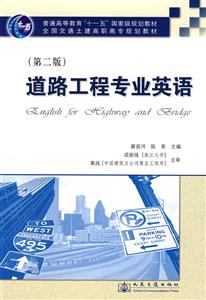-
>
鲍勃·迪伦诗歌集:1961-2012:典藏版
-
>
双城记-英文版
-
>
四级词汇词根+联想记忆法:乱序版
-
>
The secret garden
-
>
哈克贝利.费恩历险记/床头灯英语.2000词读物(英汉对照)
-
>
10000德语分类词汇联想记忆
-
>
英语词汇全书
道路工程专业英语-(第二版) 版权信息
- ISBN:9787114072390
- 条形码:9787114072390 ; 978-7-114-07239-0
- 装帧:暂无
- 册数:暂无
- 重量:暂无
- 所属分类:>>
道路工程专业英语-(第二版) 本书特色
本书是在原2002年出版的交通高等职业技术教育教材《道路工程专业英语》的基础上,按照教育部国家级规划教材的基本要求,进行了大幅删减、改编,由解决有无向本教材共分五大部分,section-ⅰ共16篇课文,是基于原教材内容进行的重新整合。section-ⅰ重在基本知识学习、基本词汇掌握,涉及了专业基础知识、道路专业知识、桥隧专业知识,土木工程合同、计算机、养护等相关知识;section-ⅱ、section-iiⅱ、section-ⅳ是本次修订增加的内容。section-ⅱ主要介绍了大不列颠哥伦比亚省4条公路与桥梁的修建情况,section-ⅱ既是section-ⅰ知识的运用,又是section-ⅰ一些重点词汇的加强学习;section-ⅲ主要介绍了交通工程中的常见道路标线、交通标志等;section-ⅳ介绍了一个招投标范本文件和一个合同协议文件;section-ⅴ由附录ⅰ、附录ⅱ和参考文献组成。附录ⅰ是课文中的专业词汇、术语汇总,附录ⅱ对原教材中的路桥工程专业术语汇编内容进行了适度的修正。
道路工程专业英语-(第二版) 内容简介
本书为普通高等教育“十一五”国家级规划教材,全国交通土建高职高专规划教材。内容分五大部分:第1部分为精选课文,共16篇,涉及了专业基础知识、道路专业知识、桥隧专业知识,土木工程合同、计算机、养护等相关知识;第ⅱ部分为在建和已建丁程项目,主要介绍了大不列颠哥伦比亚省(british columbia,加拿大第三大省)4条公路与桥梁的修建情况;第ⅲ部分为交通控制设施,主要介绍了交通工程中的常见道路标线、交通标志等;第ⅳ部分为招投标及合同协议,介绍了一个施工招投标范本文件和一个养护合同范本协议书;第ⅴ部分为全书精选课文的生同、短语汇总表及常用的路桥工程专业术语汇编,第ⅱ部分所选课文,内容基本涵盖了道路与桥梁施工、管理和材料等各方面内容,每篇课文后附有一定量的习题;第ⅱ、ⅲ、ⅳ部分所选题材,均来自于国外*新工程项目、技术成果或标准指南等。
本书适合于高等职业技术教育路桥、检测、监理、养护和管理及其他土建类专业英语教材,也可供交通中等职业教育土建类专业师生及各类干部培训学习,以及有关专业技术人员进一步提高专业英语阅读、翻译水平所用。
道路工程专业英语-(第二版) 目录
text 1 civil engineering
text 2 location surveys in rural areas
text 3 electronic total station
text 4 theory and method of structural design
text 5 types of asphalt and its uses
text 6 alignment design
text 7 highway subgrade
text 8 earth walls
text 9 construction of stabilization
text 10 asphalt pavement maintenance
text 11 bridge engineering
text 12 piers and abutments
text 13 reinforced concrete sridge
text 14 how tunnels are built
text 15 civil engineering contracts
text 16 use of computers in civil engineering
section-ⅱ projects
unit 1 the sea-to-sky highway improvement project
uuit 2 kicking horse canyon project
unit 3 border infrastructure program
unit 4 william r. bennett sridge
section-ⅲ markings
part 1 general
part 2 pavement and curb markings
part 3 object markers
part 4 traffic and parking control signs
section-ⅳ bidding document and contract agreement
bidding document
labor-based routine maintenance contract agreement
section-ⅴ appendix and references
appendix ⅰ vocabulary for texts
appendix ⅱ 路桥工程专业术语汇编
参考教学大纲
references
道路工程专业英语-(第二版) 节选
《道路工程专业英语(第2版)》为普通高等教育“十一五”国家级规划教材,全国交通土建高职高专规划教材。内容分五大部分:第1部分为精选课文,共16篇,涉及了专业基础知识、道路专业知识、桥隧专业知识,土木工程合同、计算机、养护等相关知识;第Ⅱ部分为在建和已建丁程项目,主要介绍了大不列颠哥伦比亚省(British Columbia,加拿大第三大省)4条公路与桥梁的修建情况;第Ⅲ部分为交通控制设施,主要介绍了交通工程中的常见道路标线、交通标志等;第Ⅳ部分为招投标及合同协议,介绍了一个施工招投标范本文件和一个养护合同范本协议书;第Ⅴ部分为全书精选课文的生同、短语汇总表及常用的路桥工程专业术语汇编,第Ⅱ部分所选课文,内容基本涵盖了道路与桥梁施工、管理和材料等各方面内容,每篇课文后附有一定量的习题;第Ⅱ、Ⅲ、Ⅳ部分所选题材,均来自于国外*新工程项目、技术成果或标准指南等。《道路工程专业英语(第2版)》适合于高等职业技术教育路桥、检测、监理、养护和管理及其他土建类专业英语教材,也可供交通中等职业教育土建类专业师生及各类干部培训学习,以及有关专业技术人员进一步提高专业英语阅读、翻译水平所用。
道路工程专业英语-(第二版) 相关资料
插图:
Traditionally, rural highway location practice has been field oriented, that is, the bulk of thelocation party's time and effort went to measurement and observation " on the ground. "Reconnaissance of the area was the first step; the locator, using available topographic maps andsometimes an airplane, explored the area. The aim was to search out feasible routes and determinesuch primary control points as mountain passes or suitable river crossings and to locate majorobstacles such as steep slopes. Reconnaissance of feasible routes came second; each of these wascovered on foot and rough measures of relative length, difficulty, and cost were taken. Where rate ofclimb was critical, slopes were measured with an Abney hand level or some comparable instrument.Often the locator "flagged" out the line as he went to establish control points for more detailedsurveys that might follow. The third step was for the survey party to run in the preliminary or P line,or, where necessary, two or more alternate lines. Distances and angles commonly were measured bytransit and taping methods; a profile was taken by differential leveling. Topographic features andcontours often were "hung onto" the P line. In the office, after the P line data plotted, the engineerlaid out the final location or alternate locations by studying the maps and profiles. Finally this L linewas staked on the ground and profiles, cross sections, and drainage were taken for it.
Modern location practice is usually based on photogrammetric techniques. The parallel totraditional methods as outlined above is striking; each contains the succeeding steps of area androute reconnaissance, preliminary-line survey, and final location. The difference is that the newmethod is "office" oriented. Field work before the final location is ready for staking is primarilydevoted to the aerial survey and ground control for it, to checking out obscure or incomplete data
- >
新文学天穹两巨星--鲁迅与胡适/红烛学术丛书(红烛学术丛书)
新文学天穹两巨星--鲁迅与胡适/红烛学术丛书(红烛学术丛书)
¥11.0¥23.0 - >
随园食单
随园食单
¥20.6¥48.0 - >
推拿
推拿
¥12.2¥32.0 - >
姑妈的宝刀
姑妈的宝刀
¥11.4¥30.0 - >
苦雨斋序跋文-周作人自编集
苦雨斋序跋文-周作人自编集
¥6.9¥16.0 - >
诗经-先民的歌唱
诗经-先民的歌唱
¥15.1¥39.8 - >
我与地坛
我与地坛
¥16.8¥28.0 - >
大红狗在马戏团-大红狗克里弗-助人
大红狗在马戏团-大红狗克里弗-助人
¥3.3¥10.0
-
汉译英基础教程:外语院校翻译系列教材
¥8.6¥27 -
财政学专业英语
¥9.5¥28 -
2022图书×抽奖盲袋
¥9.9¥25 -
2023读书月阅读盲盒——天黑,闭眼,刀谁?
¥42.3¥158 -
2022读者节纪念徽章-三星会员专属
¥45¥45.6
















